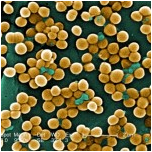MRSA and C. difficile vaccination: “An ounce of prevention worth a pound of cure”?
In a September 2013 JAMA Internal Medicine article, Health Care–Associated Infections: A Meta-analysis of Costs and Financial Impact on the US Health Care System, the authors provide estimates of the costs associated with what they termed “significant and targetable” healthcare acquired infections (HAIs).
What they determined regarding the infections they studied (catheter-associated urinary tract infections; Clostridium difficile infections; central line–associated bloodstream infections; surgical site infections; ventilator-associated pneumonias) were 440,000 infections costing an estimated $9.8 billion.
A simplistic calculation: $9.8 billion divided by the estimated 440,000 infected comes out to $22,300 per infected patient. That value should be high enough to pay for preventative methods I’d think.
A quick look at the methicillin-resistant Staphylococcus aureus data (MRSA kills more than 11,400 Americans a year) shows some 30,055 people infected at a cost of $1.38 billion or $45,900 per infected patient.
Dividing the population at risk for MRSA infection (39.7 million) into the $1.38 billion gives $35. So, theoretically, a vaccine and/or other preventative service/process costing less than $35 would be cost effective. It could be argued (by some quarters) that a prevention cost greater than $35 would be justified due to reduction of quality of life impact by those who avoided being MRSA infected.
Similar calculations could be performed for the Clostridium difficile infections (C. difficile causes diarrhea and is linked to 14,000 American deaths each year). The calculations for C. difficile are $43 per patient at risk and $11,285 per infected patient.
Those these calculations are overly simplistic they provide directional insight into the scope of the problem and the costs of the issue and related solutions. There are multiple methods possible to reduce both the number of patients infected and those who die from the infections. Basic steps such as improved hand-washing, wound and catheter care, and room sanitation methods are key. Adherence to established protocols would likely have a significant positive effect and could be achieved with little investment.
A significant improvement could come from the availability of vaccines to prevent infections. Vaccines are in development for MRSA (GSK Phase I, NovaDigm Phase I) and for C. difficile. Click on the hyperlinks for information on Sanofi Pasteur’s vaccine trial (Cdiffense) and Valneva’s Phase I program.
Photos courtesy of CDC – Div. of Healthcare Quality Promotion (DHQP); Control of Clostridium difficile-Associated Disease (CDAD); Janice Carr and CDC – Div. of Healthcare Quality Promotion (DHQP); CDC/ Janice Haney Carr/ Jeff Hageman, M.H.S.


Leave a Reply
You must be logged in to post a comment.